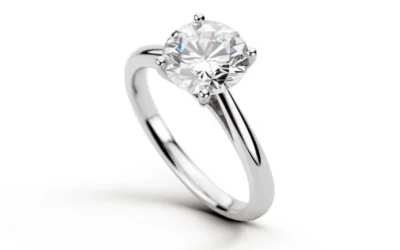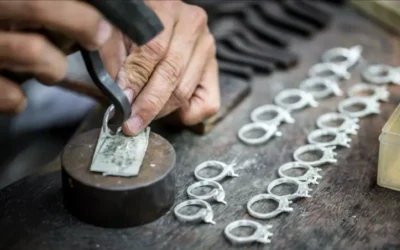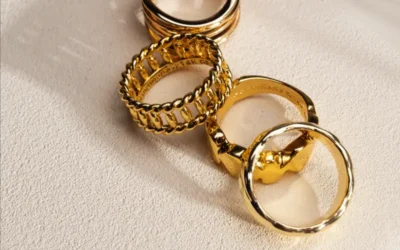Your perfect lab-grown diamond deserves an equally perfect setting—but does white gold or platinum unlock its true potential? More than a mere backdrop, the metal you choose dictates durability, aesthetics, cost, and maintenance over a lifetime. In this guide, we’ll decode the white gold versus platinum dilemma so that your ethically sourced lab-grown diamond can shine brilliantly for decades.
The ethical appeal of lab-grown diamonds lies in their conflict-free origins and reduced environmental footprint. Pairing a Type IIa lab-grown diamond—renowned for its exceptional clarity and zero impurities—with a conscious metal choice elevates your piece’s sustainability story. Whether you prefer the unwavering coolness of platinum or the mirror-bright glow of rhodium-plated white gold, understanding each metal’s chemistry and behavior is vital.
By exploring composition, appearance, resilience, and cost, this article will equip you to make an informed decision. Let’s embark on the journey to the ultimate setting for your lab-grown treasure.
Material Science Decoded: What Are You Really Buying?
 When you slip a new ring onto your finger, you’re not just choosing style—you’re investing in metallurgy. Platinum and white gold differ fundamentally in composition, density, and alloying processes, each imparting unique properties to your setting.
When you slip a new ring onto your finger, you’re not just choosing style—you’re investing in metallurgy. Platinum and white gold differ fundamentally in composition, density, and alloying processes, each imparting unique properties to your setting.
Platinum is celebrated as the “metal of eternity,” primarily because jewelry-grade platinum is typically 95% pure. Jewelers strengthen this soft base by blending in tiny amounts of iridium or ruthenium, yielding an alloy that remains naturally white.
Unlike white gold, which relies on a surface coating to achieve its pale hue, platinum’s purity means it never requires rhodium plating.Its density of approximately 21.4 g/cm³ makes it about 60% heavier than gold, giving platinum rings a substantial, reassuring weight. When you wear platinum, you feel that heft—a tactile reminder of enduring quality and craftsmanship.
White gold, on the other hand, begins life as pure yellow gold. To transform its warm tone into a cooler shade, it’s mixed with palladium, nickel, or silver alloys. Depending on the karat—14K (58.3% gold) or 18K (75% gold)—the alloy’s hardness and scratch resistance will vary.
After crafting, white gold pieces are electro-plated with a thin layer of rhodium (0.5–1.5 microns thick), lending a mirror-bright, silvery finish. This plating not only whitens but also enhances scratch resistance, though it gradually wears away under everyday friction.
Your lab-grown diamond’s brilliance interacts differently with each metal’s chemistry. Type IIa diamonds rank among the top 2% in clarity, free from nitrogen or boron impurities. Their icy transparency demands a neutral backdrop. Platinum’s inherent cool-white surface preserves true fire and scintillation, never shifting in hue. White gold’s rhodium coating offers a high-contrast frame that initially amplifies sparkle—but as plating thins, subtle yellow undertones emerge, slightly warming the diamond’s perceived color.
Beyond hue, consider workability. Platinum’s ductility enables jewelers to craft ultra-slim prongs and intricate filigree without fear of cracking, ideal for delicate, modern designs. White gold’s harder alloy resists deformation better under light pressure, keeping pavé and channel settings snug over time. By understanding these metallurgical nuances—purity, density, plating, and alloy hardness—you’ll appreciate how each metal shapes not only your ring’s look and feel but also its long-term performance and the way it highlights your lab-grown diamond.
Aesthetic Showdown: Which Metal Makes Your Diamond Shine?
At first glance, both platinum and white gold can make a lab-grown diamond look spectacular. Yet their visual characters diverge once you wear the ring through everyday life.
Platinum’s natural cool-white tone remains steadfast. Without a plating layer to wear away, platinum never yellowing, it matures into a softly luminous patina. Over years, microscopic surface marks scatter light in a subtle, vintage-inspired glow—often called a “living finish.” This evolving beauty appeals to those who appreciate a timeless, slightly muted radiance.
White gold begins with a bold statement: a dazzling, chrome-like gleam courtesy of fresh rhodium plating. In showroom lighting, white gold settings can appear almost brighter than platinum, creating eye-catching contrast against your diamond’s facets. That initial high-polish brilliance, however, is skin-deep. As daily wear introduces scratches, the underlying gold alloy peeks through, imparting a faint warmth. Re-plating restores that mirror shine, but it requires periodic attention—generally every 12 to 24 months.
Consider how setting styles interact with each metal’s aesthetic. When it comes to prongs, platinum’s strength allows artisans to craft delicate yet resilient claws that hold the diamond with minimal metal obstruction. This maximizes light entry and fire. In pavé or channel settings, white gold’s hardness ensures small accent stones stay tight and aligned. Yet platinum’s malleability simplifies resizing or repairs, preserving the seamless appearance of continuous channels or intricate motifs.
Ultimately, your choice hinges on whether you prioritize enduring consistency or initial dazzle. If you value a steadfast, ever-refined glow, platinum’s natural whiteness and evolving patina will complement your lab-grown diamond for life. If you crave the flashiest first impression and don’t mind routine upkeep, white gold’s rhodium brilliance offers maximum sparkle on day one.
Durability & Maintenance: The Long-Term Reality
Beauty entwines with resilience when it comes to precious-metal settings. Understanding how platinum and white gold respond to wear will shape your expectations for maintenance and longevity.
Platinum resists wear in a unique way: rather than thinning or losing material, its surface shifts under pressure. Tiny plowing marks appear, but the overall thickness remains intact, ensuring prongs and bands do not grow thinner. Over time, these surface marks blend into a soft patina that diffuses light and hides small scratches. A professional polish every three to five years—often under $100—restores a lustrous finish without removing significant material. Because platinum displaces instead of erodes, heirloom pieces can last centuries with minimal structural change.
White gold experiences wear differently. Daily knocks create fine scratches that collect beneath the rhodium coating. Although fresh plating conceals these marks, each replating session (typically $75–$150) wears away a bit of metal over the long term. Eventually, after many cycles, alloy thickness diminishes, and prongs may require rebuilding to guarantee security. Jewelers often recommend rhodium re-plating every one to three years, depending on lifestyle and exposure.
For those with active lifestyles—hand-heavy work, regular sports, or frequent travel—platinum’s “set-and-forget” nature provides peace of mind. Your setting maintains its integrity, and the risk of stone loosening diminishes. Budget-minded buyers or occasional wearers may find white gold’s periodic maintenance acceptable in exchange for a lower initial price. Scheduling regular inspections—ideally every six to twelve months—ensures prongs remain secure, regardless of metal choice. By aligning your maintenance plans with daily habits, you can preserve the brilliance and safety of both platinum and white gold settings for generations.
Cost Analysis: Price Tags & Hidden Expenses
Cost often ranks high on the decision matrix for engagement rings. While platinum exudes luxury, white gold offers a more accessible entry point. Yet a closer look at both upfront and ongoing expenses reveals a nuanced picture.
 Upfront, platinum commands a premium. A classic solitaire platinum mounting may start around $1,500, contrasted with approximately $800 for a comparable 14K white gold setting. That difference stems from platinum’s higher market price per ounce and the labor intensity of working with a denser, more ductile metal. Jewelers invest extra time crafting platinum’s meticulous joins and laser-welded prongs, reflecting in the price tag.
Upfront, platinum commands a premium. A classic solitaire platinum mounting may start around $1,500, contrasted with approximately $800 for a comparable 14K white gold setting. That difference stems from platinum’s higher market price per ounce and the labor intensity of working with a denser, more ductile metal. Jewelers invest extra time crafting platinum’s meticulous joins and laser-welded prongs, reflecting in the price tag.
However, white gold’s lower entry cost comes with hidden upkeep fees. Rhodium plating—integral to white gold’s signature shine—must be refreshed every one to three years. Each session, costing $75 to $150, strips and replants a new layer. Over a decade, re-plating can total $300 to $1,500, erasing much of the initial saving. In contrast, platinum requires only occasional polishing, typically under $100 per service, to maintain its luster without altering metal thickness.
When evaluating long-term value, consider resale potential and insurance implications. Platinum’s higher intrinsic value per gram often translates to higher replacement cost assessments by insurers, which can inflate premiums but also reinforce the piece’s perceived worth. White gold’s lower metal value may yield marginally lower insurance rates, though policy specifics vary widely.
Many couples offset these costs by choosing lab-grown diamonds, which run 50–60% less than mined counterparts. Those savings free budget space for premium settings—allowing equal diamond carat and color paired with platinum’s enduring sheen. Alternatively, you might allocate savings toward a larger white gold set stone, balancing visual impact against maintenance commitments. Ultimately, aligning your financial priorities with expected upkeep will yield the most satisfying blend of sparkle, durability, and value.
The Perfect Pair: Recommendations by Lifestyle & Design
Selecting the ideal metal depends less on absolutes and more on your personal story—your lifestyle habits, aesthetic inclinations, and long-term vision for the ring. Here are in-depth scenarios to help you find your perfect pairing.
For the Heirloom Enthusiast
If you envision the ring traveling through generations, platinum’s enduring nature and evolving patina make it the gold standard. Its high purity ensures hypoallergenic wear, eliminating worries about nickel sensitivities. Over centuries, platinum settings maintain structural integrity—prongs may develop a gentle sheen, but they never thin away. The ring will age gracefully, its patina narrating a legacy of love.
For the Fashion-Forward Minimalist
Modern tension or bezel settings demand precision. Platinum’s strength and low melting point permit jewelers to form ultra-slim edges that hold diamonds with near-invisible metal. If you favor bold architectural lines or avant-garde silhouettes where the diamond appears to float, platinum empowers those clean, uninterrupted forms without risk of cracking.
For the Budget-Savvy Maximalist
If diamond size thrills you more than metal prestige, white gold lets you stretch further. The initial cost savings allow a larger lab-grown center stone, boosting visual impact. Pair an eye-catching 2-carat Type IIa diamond with 14K white gold for about the same budget it would take to set a 1.5-carat stone in platinum. You’ll enjoy immediate brilliance, provided you’re open to re-plating every couple of years to keep the sheen at its peak.
For the Detail-Oriented Romantic
Intricate filigree, milgrain edges, and pavé halos showcase artisan skill. White gold’s harder alloy anchors tiny accent stones securely, ensuring pavé settings remain crisp. Yet if you appreciate seamless, continuous channels and prefer occasional polish over yearly replating, choose platinum. Its malleability enhances bezels and gallery work, making repairs and resizing nearly invisible.
For the Eco-Conscious Collector
Both metals offer recycled and responsibly sourced options. If environmental impact guides every choice, seek out jewelers providing recycled platinum or Fairmined gold. Pair your lab-grown diamond’s clean pedigree with metals that carry reduced mining footprint certifications, completing an eco-friendly ensemble.
In each scenario, personalize further: consider mixed-metal shanks with a platinum band and white gold head for contrast, or stackable accent rings in rose gold alongside a white gold centerpiece. The key is aligning metal attributes—weight, patina, maintenance—with your unique story. By intertwining lifestyle insights with metallurgical realities, you’ll select a setting that not only showcases your lab-grown diamond but feels inherently yours.
Expert Buying Guide: Certificates, Settings & Lab-Grown Specifics
Making a confident purchase extends beyond choosing metal; certification and craftsmanship matter equally. Here’s what every savvy buyer should verify:
First, insist on an IGI (International Gemological Institute) certificate for your lab-grown diamond. Unlike GIA, which specializes in natural stones, IGI provides unbiased grading for lab-created gems, detailing color (D–Z), clarity (FL–I), cut quality, polish, and symmetry. Examine the certificate’s depth and table percentages to verify light performance. Ensure measurements align with advertised carat weight to avoid surprises.
Next, scrutinize the metalwork. For platinum settings, request evidence of laser-welded prongs rather than traditional soldering. Laser welding preserves platinum’s purity and eliminates weaker metal joints. Under magnification, prongs should exhibit smooth, uniform shoulders with no visible seams. For white gold, inspect rhodium plating thickness under a loupe; anything under 0.5 microns will discolor rapidly. Ask your jeweler to specify plating thickness and warranty coverage for replating.
When it comes to lab-grown diamond types, be aware of CVD (Chemical Vapor Deposition) versus HPHT (High Pressure High Temperature) processes. CVD stones often exhibit fewer internal graining lines and exceptional clarity, but their heightened sparkle can betray metal flaws beneath thin plating. Pair such stones with platinum to maintain visual harmony.
Ask for CAD renderings or 3D wax models before production. Visualizing how diamond and metal interplay helps prevent surprises. Confirm whether your purchase includes complimentary polishing or replating within the first year—some reputable jewelers include one service free to ensure customer satisfaction.
Finally, inquire about ethical metal sourcing. Many jewelers now offer recycled platinum and Fairmined gold, which reduces the environmental and social impacts of mining. Matching your lab-grown diamond’s green credentials with responsibly sourced metal completes a fully conscious purchase, ensuring every facet of your ring aligns with your values.
FAQs: Answering Your Top Concerns
Can you resize platinum and white gold rings easily?
Both metals accommodate resizing, but platinum’s ductility simplifies stretching or cutting without risk of cracking. White gold also resizes well but typically requires a rhodium replating service afterward to restore its white finish.
 Which metal is truly hypoallergenic?
Which metal is truly hypoallergenic?
Platinum at 95% purity is virtually allergen-free. White gold alloys may contain nickel or palladium, which can irritate highly sensitive skin once rhodium plating thins.
Does a platinum setting increase a lab diamond’s resale value?
While platinum enhances perceived luxury and durability, it doesn’t directly elevate the diamond’s resale price. However, insurers often view platinum settings as higher replacement-cost items, affecting coverage terms.
How often should I have my ring inspected?
Aim for a professional check-up every six to twelve months. Jewelers will tighten prongs, assess plating integrity, and recommend polishing or replating as needed to preserve both safety and brilliance.
Is rhodium plating safe for everyday wear?
Yes—rhodium plating is a standard, safe process. It bonds securely to white gold and withstands normal activities. Over time, friction wears it down, but it poses no health risks.
Conclusion: Your Diamond, Your Legacy
Choosing between white gold and platinum ultimately comes down to balancing priorities. Platinum offers unmatched purity, hypoallergenic comfort, and a “living” patina that speaks to timeless heirlooms. White gold delivers immediate, dazzling brilliance and budget-friendly entry with manageable upkeep through rhodium plating.
By aligning your decision with lifestyle habits, design aspirations, and ethical values, you’ll select a setting that not only showcases your lab-grown diamond’s sparkle but becomes an enduring symbol of your story. Whether you opt for platinum’s steadfast glow or white gold’s mirror-bright allure, your ring will reflect both your personal taste and your commitment to responsible luxury—ensuring it remains a cherished legacy for generations to come.






